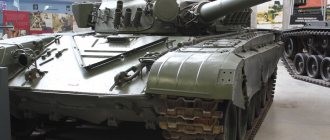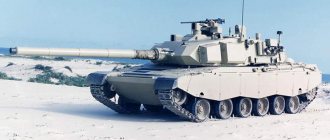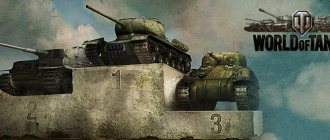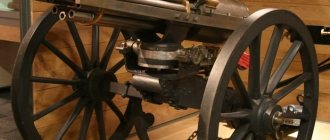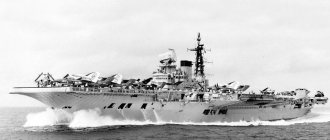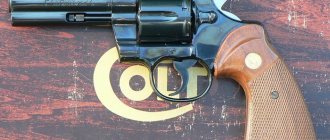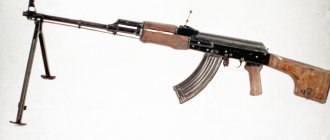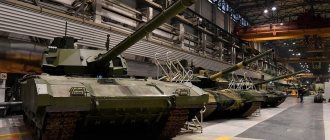The military conflicts of recent decades, in which the center of combat clashes has mostly moved to urban areas, have made adjustments to the development trends of armored vehicles.
In addition, the rapid development of anti-tank weapons and the appearance in the armies of many countries of large-caliber snipers, or as they are called in the West, “antimaterial guns,” which can be translated as rifles against equipment, also played a role. In this regard, armored vehicle designers began developing armored vehicles designed to equip motorized infantry (motorized rifle) units, with a higher level of protection, approximately the same as a tank. The most rational way to create such combat vehicles for infantry was to convert obsolete tank models into armored personnel carriers. By a strange coincidence (and perhaps quite naturally), the most common type of tank, which served as the basis for the creation of heavy armored personnel carriers, became the Soviet T-55. In this issue, we offer readers materials about the transformation of the T-55 into an infantry vehicle, and will also tell you about some other types of heavy armored personnel carriers.
↑ RUSSIA. HEAVY ARMORED TRANSPORTER BTR-T
Russian heavy armored personnel carrier BTR-T, armed with a 30-mm automatic cannon and ATGM "Konkurs"
Creation
To provide a higher level of protection for infantrymen of motorized rifle units operating in conjunction with tanks, in Russia on the basis of the T-55 tank chassis by the Omsk Design Bureau of Transport Engineering (KBTM ) a prototype of a new heavy armored personnel carrier was developed, designated BTR-T (heavy armored personnel carrier). It was first demonstrated at the VTTV-97 arms exhibition in Omsk in 1997.
The construction of the BTR-T heavy armored personnel carrier was carried out at the Omsk Transport Engineering Plant (Omsktransmash).
According to the designers, the large number of T-55 tanks available in Russia, which can be converted into BTR-T, would provide the army with relatively inexpensive and highly protected infantry fighting vehicles. According to some sources, the export price of the BTR-T is 600 thousand USD, respectively, converting the T-55 tank into the BTR-T is much cheaper.
Russian heavy armored personnel carrier BTR-T, armed with a 30-mm automatic cannon and ATGM "Konkurs"
Design
The new heavy armored personnel carrier BTR-T is based on the chassis of the T-55 tank, from which the turret was removed and the hull was expanded to provide additional space for the crew and troops in the front part of the machine and the engine-transmission compartment stored in the rear part of the machine.
The crew of the car consists of two people. The driver is in the front part in the same place and the commander-gunner is in the turret. The troop compartment can carry five fully equipped infantrymen.
For landing and landing of troops there are hatches in the roof: in front on the right and behind the turret. Since the roof of the habitable compartment is higher than the level of the hull roof, two more hatches were made in the rear part of the cabin. The covers of these hatches open upward and have built-in prism blocks for observation. For the same purpose, the troop compartment is also equipped with periscope devices.
The BTR-T heavy armored personnel carrier has a combat weight of 38.5 tons (compared to 36 tons of the standard T-55 tank). If we take into account that the BTR-T body has a mass of 27 tons, it becomes clear that the bulk of the BTR-T’s increased weight by more than 10 tons went to strengthening the armor protection of the vehicle.
The frontal armor parts and sides are equipped with the latest generation Kontakt-5 dynamic protection package, which provides a high level of protection not only against cumulative, but also against armor-piercing sub-caliber ammunition. A similar remote sensing system is used on modern Russian T-80U and T-90S tanks.
In addition, the BTR-T has a reinforced hull bottom to increase the vehicle’s survivability when detonated by anti-tank mines. This is ensured by additional armoring of the bottom, which is welded to it at intervals, forming an air gap between the additional armor and the bottom itself, which significantly reduces the impact of a blast wave when detonated by a mine.
In order to compensate for the increased mass and maintain mobility at the same level, no lower than it was on the T-55 tank, a more powerful V-46-6 engine was installed on the vehicle, developing a power of 780 hp. The car's transmission has also been improved.
A low-profile turret is installed in the front part of the hull, on which elements of the weapon system are mounted.
The weapon system on the BTR-T may have a different composition, because it is made in the form of various modules that can be installed on the machine depending on its purpose or customer requirements.
Weapon options for installation on the BTR-T
The following weapon options for the BTR-T are provided:
- 30-mm 2A42 automatic cannon and two Konkurs ATGM launchers;
- 30-mm automatic cannon 2A42 and 30-mm automatic grenade launcher AG-17;
- Two double-barreled 30-mm machine guns 2A38;
- 12.7 mm NSVT-12.7 “Utes” (or “Kord”) machine gun and two “Konkurs” ATGM launchers;
- 12.7 mm NSVT-12.7 “Utes” (or “Kord”) machine gun and 30 mm AG-17 automatic grenade launcher.
In addition, in addition to the use of Russian-designed and produced weapons as part of modules with a weapon complex, they can also be equipped with Western-made weapons.
Like many Russian-made armored combat vehicles, the BTR-T has thermal smoke equipment for setting up smoke screens by injecting fuel into the exhaust tract. In addition, there are four blocks (three launchers each) for launching smoke or aerosol grenades. Smoke (aerosol) curtains from these blocks are placed in front of the vehicle.
Main tactical and technical characteristics of the heavy BTR-T:
- Combat weight, t - 38.5
- Crew + landing party, people - 2+5
- Maximum speed, km/h — 50
- Engine - brand - V-46-6 - power, hp. — 780
- Armament (option): - main - 30 mm 2A42 automatic cannon - additional - 7.62 mm PKT coaxial machine gun - guided weapon system - Konkurs-M ATGM launcher
- Ammunition, (shots): - for the 30-mm 2A42 cannon - 200 - for the PKT machine gun - 2000 - for the ATGM - 3
- Armor protection - provides protection against RPGs and ATGMs
Modifications
BTR-40
BTR-40 (1947) - basic model with an open top.
BTR-40A
BTR-40A (1951) - an air defense vehicle, equipped with a ZTPU-2 anti-aircraft gun with coaxial 14.5 mm KPV machine guns, combat weight 5.6 tons.
BTR-40B
BTR-40B (1958) - with an armored hull roof, series in 1957-60. Body forehead - 6-8 mm. Crew - 2+6 people. Weight - 5.3 tons. Created as a result of events in Hungary.
BTR-40РХ
BTR-40РХ - chemical reconnaissance vehicle. With VPHR, automatic gas analyzer, radiometer-X-ray meter DP-5A, X-ray meter DP-3B
BTR-40A railway
BTR-40A railway (1969) - a modification for railway troops, equipped with a device (additional lifting wheels with flanges) for movement along railway tracks; converted directly into units.
BTR-40 (1948) - experimental with a 14.5 mm KPV machine gun
BTR-40V (1956) - experimental, with a centralized system for regulating air pressure in tires and a self-locking differential of the cracker type. Equipped with a filter ventilation system. Small series in 1957
↑ JORDAN. HEAVY APC AB14 TEMSAH
“Temsah”, armed with a 20-mm cannon and a 4-container ATGM launcher
If just two decades ago the construction and even modernization of armored vehicles was the fate of only a small number of states with a high level of industry, then recently there has been an increase in manufacturers of such equipment.
The Hashemite Kingdom of Jordan has recently joined their ranks. For almost the last ten years, the Jordanian company KADDB (King Abdullah II Design and Development Bureau) has been presenting its developments in the field of armored vehicles at international arms exhibitions. With regard to tanks, KADDB was modernizing them, but with regard to heavy infantry fighting vehicles, it was able to present a new development. However, this is understandable; heavy armored personnel carriers and infantry fighting vehicles were born in the Middle East, although they first appeared on the other side of the Jordan. Due to certain circumstances, Arab countries do not adopt Israeli experience and do not invite specialists from this country. In addition, there are no Soviet-built tanks in Jordan. With the participation of (MDB) from South Africa, the American General Dynamics Land Systems and the Jordanian CLS, a highly protected infantry fighting vehicle AB14 Temsah was created. It is designed on the basis of the Centurion tank chassis. However, it had to be considerably rearranged, so we can say that “Temsah” is a purely Jordanian creation.
Layout
The layout of the new car is made with a front-mounted power plant. In other words, the hull of the Centurion tank was turned 180 degrees. The vehicle's power plant uses an American AVDS 1790 diesel engine with a power of 950 hp, which is also used in the modernization of M60A1 tanks in Jordan. The transmission is automatic CD 1000, has two forward gears and one reverse gear. The suspension of the armored personnel carrier is hydropneumatic balanced. The dynamic stroke of the roller is +350 and -100 mm.
Interior "Temsah"
The vehicle's armor has been significantly enhanced compared to the base chassis of the Centurion tank. It provides protection for the crew and troops inside the vehicle not only from small arms fire, but also from artillery ammunition. The design of the hull provides for the installation of dynamic protection, which will make the heavy armored personnel carrier more survivable when exposed to fire from hand-held anti-tank grenade launchers. True, it is not reported whose developments formed the basis of the proposed dynamic protection. In addition, the developers believe that the front location of the power plant increases the survivability of the vehicle’s crew on the battlefield when fired from the frontal projections. The body of the armored personnel carrier has a relatively small height, just over two meters, which also, in the opinion of the vehicle’s creators, increases its survivability on the battlefield. The hull superstructures—turrets with various weapon systems—are uninhabited and controlled remotely from the vehicle’s hull.
Recently, KADDB presented another example of the Temsah heavy armored personnel carrier, which does not have any weapon system at all. On the roof of the vehicle body there is a small superstructure with relatively large armored glass on all sides, providing good visibility from the vehicle. If necessary, these glasses are covered with armored shields, which have slots for observation.
Jordanian heavy armored personnel carrier "Temsah" with a superstructure (driver's turret) and without weapons
The crew of the Temsah armored personnel carrier consists of two people: a driver and a commander, who is also the operator of the weapons complex. The airborne infantry fighting vehicle squad is designed to accommodate 10 infantrymen in full gear. It should be noted that it is quite spacious and has a length of 3350 mm, a width of 1770 mm and a height of 1455 mm.
The vehicle is not equipped with loopholes for firing personal weapons. However, to monitor the terrain by the landing party, television cameras can be installed, and inside the landing compartment there are 4 liquid crystal television monitors. The infantrymen in the vehicle are positioned along the sides, with their backs to them. For landing and landing of troops, the vehicle is equipped with a folding ramp in the rear part with a mechanical drive. There are also hatches in the rear of the troop compartment roof. Their number, depending on the version of the machine, can be different - from one to six.
Inside the vehicle, under the landing seats, there are stowages for dry rations and water for all people in the vehicle. According to the developers, water and food supplies provide the vehicle with the ability to operate autonomously for 48 hours.
Options
The vehicle's armament may vary. Until now, two weapons variants of the Temsah armored personnel carrier have been demonstrated: one, as part of the armament complex, uses a large-caliber machine gun installed in a remotely controlled turret module, and two INGWE ATGM launchers, manufactured in South Africa. In another version - with an automatic 20-mm cannon, a coaxial machine gun and 4 INGWE ATGM launchers, also installed in a remotely controlled turret module.
The Temsah's weapons are stabilized in two planes. The rate of fire of the automatic cannon is 200 rounds per minute, its ammunition load is 300 shells, of which only 150 are ready for use. The rest are stowed in the vehicle and need to be loaded after using up the ammunition belt located on the turret. The target firing range of the cannon is 2000 m. The cannon can fire in single shots or in bursts.
"Temsah", armed with a 20-mm automatic cannon and a two-container ATGM launcher (ZT-35 "Ingwe") in the turret. The
7.62-mm M240 coaxial machine gun is a tank version of the famous Belgian FN MAG.
The target firing range is 1200 m, the ammunition load is 2600 rounds, of which only 600 are ready for use. The remaining 2000 pieces. stowed inside the troop compartment of the vehicle. The ATGM ammunition load is 4 missiles - only those in the launchers. The firing range of the INGWE ATGM is from 500 to 5000 m. To set up smoke screens, smoke grenade launchers are mounted on the turret module.
The weapon is aimed remotely from the vehicle body. Observation of the battlefield and aiming is carried out on a liquid crystal television monitor installed at the vehicle commander’s workplace. The elevation angles of the weapon range from -8 to +40 degrees, which, in my opinion, is not quite sufficient, since the vehicle is designed to operate in city conditions and mountainous terrain, which is more than enough in Jordan.
Options are envisaged for using the Temsah armored personnel carrier chassis as a tracked armored medical vehicle, a command post, as well as for a base for self-propelled guns and mortars.
The Temsah armored personnel carrier as a platform for weapons.
As standard, the vehicle is equipped with collective protection systems, air conditioning and a fire fighting system.
The main tactical and technical characteristics of the heavy armored personnel carrier "Temsah":
- Combat weight, t - 49.5
- Crew + landing party, people - 2+10
- Dimensions, mm: — length — 7962 — width — 3766 — body roof height — 2080 — ground clearance — 500
- Engine - brand - AVDS 1790 - power, hp. — 950 Specific power, hp/t — 19.2 Permissible payload, t — 4
- Armament (option): - main - 20 mm automatic cannon - additional - 7.62 mm M240 machine gun - guided weapon system - INGWE PU ATGM
- Ammunition, (shots): - for 20-mm cannon - 150+150 - for M240 machine gun - 600+2000 - for ATGM - 4
- Fuel capacity, l - 950
- Armor protection - provides protection against RPGs
Development
During World War II, Germany actively used the SdKfz 250 and SdKfz 251 half-track armored personnel carriers. They served as real workhorses, serving as communications, headquarters and ambulance vehicles. Transportation of wounded soldiers and towing of various weapons were continuously carried out using these vehicles on all fronts throughout the war.
It is worth mentioning Universal Carrier from the UK. This tracked vehicle was supplied to the Allies and was produced in quantities of more than 90,000 units.
In the post-war period, rapid development of such equipment began in the USSR and NATO countries, but ideas about the necessary characteristics differed.
First of all, the armored personnel carrier is considered a universal vehicle that transports troops under the protection of armor. To overcome water obstacles, amphibiousness is necessary; the United States paid special attention to it, which used the equipment to deliver troops by sea. At the same time, sufficient seaworthiness was necessary, and they did not pay much attention to the mass, since it inevitably grew along with an increase in protection and the possibility of installing powerful weapons.
In the USSR, they relied on air transportability, which resulted in strict restrictions on weight and size. The weight should not exceed 20 tons, and the dimensions should be the dimensions of a standard railway platform.
↑ ISRAEL. HEAVY ARMORED TRANSPORTER "ACHZARIT"
Israeli heavy tracked armored personnel carrier "Akhzarit" Mk1 created on the basis of the T-55 tank.
Creation
Israel is considered a pioneer in the creation of heavy armored personnel carriers. Israeli engineers were prompted to this by the experience of the war in Lebanon in 1982, most of the fighting was fought in urban conditions. If the American-made M60A1 tanks in service with the Israeli Defense Forces (IDF) were to some extent protected from fire from hand-held anti-tank grenade launchers by the dynamic protection (RA) used for the first time, then the American M113 armored personnel carriers became easy prey for Arab grenade launchers. Israeli Merkava Mk1 tanks were not equipped with dynamic protection. It was believed that the level of protection and survivability on the battlefield of this vehicle was already quite high. But in vain. The Merkavas were burning from grenade launcher fire, like all the other tanks. But still, armored personnel carriers and the infantry sitting in them suffered the most.
Having studied the experience of that war, the SDI leadership developed tactical and technical specifications for the development of a heavy armored personnel carrier, which later received the name “Achzarit”. In accordance with them, it was supposed to be a highly protected vehicle, capable of operating in local conditions together with the main Merkava tanks. The idea of creating such a vehicle was prompted by the successful use in urban conditions as a means of delivering infantry to the battlefield of the Puma engineering barrier vehicle, made on the chassis of the Centurion main tank.
Israeli heavy tracked armored personnel carrier "Akhzarit" Mk1 created on the basis of the T-55 tank.
The development of heavy armored personnel carriers in Israel initially envisaged the use of a variety of chassis, including the chassis of the Merkava and Centurion tanks. The first prototypes of the Achzarit armored personnel carrier were built in 1987. Subsequently, an option was developed to create a vehicle on the chassis of the T-55 tank, which in large quantities went to the Israeli army as trophies during the Arab-Israeli wars and then for several years were restored for SOI.
Akhzarit Mk1 armored personnel carrier with an additional commander's cupola
Tests of prototype Achzarit vehicles based on the T-55 showed some advantages compared to previously tested options and especially the lower cost of the vehicle.
They were adopted by the Israeli Defense Forces as a heavy armored personnel carrier and the start of their mass production took place in 1988. The production of heavy Achzarit armored personnel carriers was carried out in SOI workshops and at the Military Plant located in Tel Hashomer, which is not far from Tel Aviv. According to various estimates, there are currently approximately 400-500 such vehicles in the Israeli armed forces.
Heavy armored personnel carrier "Akhzarit" Mk1 overcomes the descent
Vehicle design
When rebuilding the T-55 tank into a heavy armored personnel carrier, its chassis is completely disassembled and then restored, but with some modifications. The tank's turret is dismantled and an additional superstructure is welded onto the vehicle's body in the area of the crew compartment, which forms the control compartment and the troop compartment. The engine and transmission compartment is located at the rear of the vehicle, but instead of the standard engine and transmission, a power plant from the Israeli company NIMDA is installed in it, which has slightly smaller dimensions and a more powerful engine.
Additional armor developed in Israel is installed on the body of the vehicle, which, according to the developers, provides this vehicle with the best protection among all available vehicles of this type in the world.
The habitable compartment of the vehicle can accommodate up to 10 people, including a crew of three: the vehicle commander, driver and machine gun gunner. The driver's seat remains at the front left. Above it there is a separate hatch, the lid of which opens to the left. Four periscope daytime surveillance devices are installed in front of the hatch, one of which in the center can be replaced with a passive night surveillance device for night driving.
The commander of the vehicle is located to the right of the driver and has a rotating periscope daytime observation device mounted on the roof of the vehicle and a square hatch, the lid of which opens to the rear. On the right in front of the vehicle is the machine gun gunner, who controls the RAFAEL Overhead Weapon Station with a 7.62 mm M240 machine gun mounted on it. The machine gun is stabilized in two planes and is aimed using remote control from inside the vehicle. The installation's sighting complex is equipped with day and night thermal imaging sights.
In addition to the remote-controlled machine gun mount, the Achzarit armored personnel carrier also has three additional 7.62 mm machine guns mounted on pivot mounts: one on the vehicle commander’s hatch and two in the rear of the vehicle’s troop compartment. To fire from these machine guns, you need to open the hatch covers and lean out of them.
Seven infantrymen are accommodated in the rear crew compartment of the vehicle: three in a solid bench seat on the left side, three in individual jump seats on the right, and one centrally located at the rear of the troop compartment.
Aft door with a ramp for the exit of infantrymen.
The driver, commander and gunner of the machine gun mount each have their own hatch.
The commander's hatch cover can be opened halfway for observation. Behind the vehicle crew hatches there are two additional hatches: one in the center of the troop compartment and the other slightly to the left and behind. The stock B-55 diesel engine and manual transmission were removed and a NIMDA power plant was installed. This unusual and extremely compact power plant made it possible to make an exit for the landing force at the rear of the vehicle on the right side, closed by an armored hydraulically hinged door. Its lower part folds down and serves as a ladder, and the upper part opens upward. The aft exit for the landing was made without changing the configuration of the vehicle hull. In addition, infantry can embark and disembark through hatches in the roof of the crew compartment.
The power plant combines various units, the main ones of which are identical to those used on the modernized version of the Soviet T-55 tank in Israel, which received the name “Samovar” there, as well as on the American 155-mm self-propelled gun M109. Both of these types of vehicles are used in large numbers by the Israeli Defense Forces.
The power plant of the Achzarit Mk1 armored personnel carrier, supplied by the Israeli company NIMDA, consists of an American two-stroke liquid-cooled diesel engine Detroit Diesel 8V-71 TTA, developing a power of 650 hp. The engine is mounted across the vehicle body and connected to an Allison XTG-411-4 hydrodynamic automatic transmission, also manufactured in the USA.
Air intake from the engine is carried out either through the fighting compartment or through the engine-transmission compartment. In both cases, the air enters initially through a pre-filter that has a dust emission fan, and then through a paper air cleaner, similar to those found on cars.
Interior The
chassis of the T-55 tank, consisting of five road wheels, a drive wheel at the rear and a idler wheel at the front on each side, has also been modernized.
The suspension units of the road wheels are equipped with new torsion shafts, which made it possible to increase the dynamic travel of the roller, and the first and last suspension units are equipped with hydraulic stops, which are also used on Merkava tanks. This suspension upgrade provides the vehicle with better mobility over rough terrain and allows it to operate in conjunction with main tanks. The combat weight of the Achzarit armored personnel carrier increased to 44 tons compared to 36 tons for the T-55 tanks. As already mentioned, the T-55 turret is dismantled when converting it into an Achzarit armored personnel carrier. The main difference in weight between the weight of the Achzarit armored personnel carrier, which has 44 tons, and the T-55 hull weight of 27 tons, is explained by the installation of additional armor protection to increase the survivability of the vehicle on the battlefield. The total height of the hull roof is approximately 2 m, and the width of the vehicle is 3.64 m.
On both sides of the hull in the front part there are six launchers of CL-303Q smoke grenade launchers manufactured by . Such grenade launchers were originally installed on Israeli Centurion, M48/M60 and Merkava tanks. They can fire various types of grenades as the vehicle moves.
Standard equipment of the Achzarit armored personnel carrier includes the Spectronix fire detection and extinguishing system, a collective protection system against weapons of mass destruction and thermal smoke equipment for setting up smoke screens, using the principle of fuel injection into the engine exhaust manifold located on the left side of the hull.
Currently, the SDI has a variant of the heavy armored personnel carrier "Achzarit" Mk2. This vehicle has a new power plant, also supplied by the Israeli company NIMDA. It includes an American Detroit Diesel 8V-92 TA diesel engine, developing 850 hp, connected to an American Allison XTG-411-5 automatic transmission. This power plant provides the vehicle with higher power density and better acceleration characteristics. To date, the “Achzarit” Mk2 model is the last example of this heavy armored personnel carrier.
Israeli heavy armored personnel carrier "Ahzarit" Mk2
In addition, on the basis of the heavy armored personnel carrier "Achzarit", a version of the command and staff vehicle was created, which differs from the standard armored personnel carrier in the absence of machine guns on the roof of the vehicle and the addition of additional radio stations to perform specialized control functions.
The main tactical and technical characteristics of the heavy armored personnel carrier Achzarit:
- Combat weight, t - 44
- Crew + landing party, people - 3+7
- Maximum speed, km/h — 50
- Engine – brand – “Detroit Diesel” 8V-92 TA – power, hp. — 850
- Armament: - main - 7.62 mm M240 machine gun with remote control - additional - two 7.62 mm FN MAG machine guns
- Armor protection - provides protection against RPGs
Defense instead of a tower
The T-72 hull without turret weighs about 30 tons. Without straining the chassis unnecessarily, we have 16 tons of reserves for strengthening armor and installing weapons. We can weld additional armor plates onto the hull, making sure to strengthen the rear part, and install containers with dynamic protection.
We will screw individual seats to the wall, and cover the walls with Kevlar lining to protect against fragments, install good optics, a digital radio station and other things that suit the spirit of the times.
The final weight of an armored personnel carrier and, accordingly, its protection depend on how powerful and at the same time compact the engine our manufacturers offer. Still, the thrust-to-weight ratio is of great importance for motorized rifle “wheels”. It will be good if the specific power is at least 22 horsepower per ton.
